The competition between TVs and projectors is intensifying every year. Probably, their further improvement will ultimately create the preconditions for creating a media hybrid, removing a discussion about their pros & cons. Physically, the projector screen can quite function as a display, and a modern TV can be positioned as an Ultra Short Throw (UST) projector. But today both directions continue to develop rapidly.
Of course, the requirements for living room projectors differ significantly from traditional models. First, they need to be bright enough because ambient lighting in a living room is usually bright due to diffused daylight. Secondly, placing the projector in the center of the living room is not very convenient due to the wires. From this point of view, UST (Ultra Short Throw) models are much more preferable because they are placed very close to the screen.
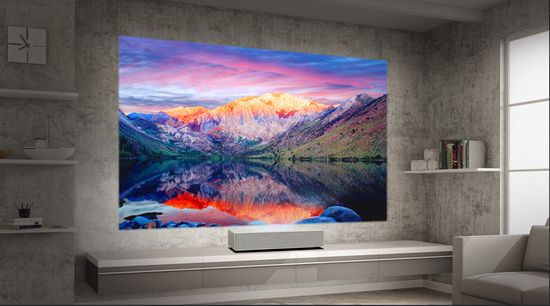
Given these factors, the companies have developed a new class of UST laser smart streaming projectors that are ideally for watching TV channels in the living room.
Light source selection and UST design is due to several factors. First, unlike the LED projectors, the laser models are bright enough to work in daylight. Secondly, unlike traditional lamp-based projectors, they have very low noise levels due to the lack of a powerful fan. As known, lamp projectors are forced to use them for cooling during operation. Third, UST design radically simplifies placement.
The formation of the segment of living room projectors can be considered the logical completion of this trend. In recent years, Optoma, LG, Hisense, and Samsung have been offering such models. Of course, Epson did not stand aside. Its new Epson EpiqVision line of laser projectors has significantly expanded the range of living room projectors.
LED LCD TVs evolution
2012 can be considered a turning point in the development of TVs. OLED (organic light-emitting diode) technology has allowed developers to abandon LED backlight. This provided virtually infinite image contrast with perfect blacks due to the lack of backlight stray light. At that time, many experts quite reasonably predicted the complete displacement of traditional LCD TVs due to the huge difference in picture quality.
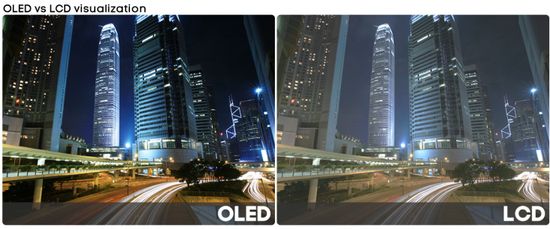
But the high price, relatively low brightness, and limited blue pixel life (15,000 hours) have tweaked these predictions. As a result, industry leaders continued to actively improve the traditional LED LCD technology.
Soon Samsung offered Quantum Dot display technology.
This sleek solution has dramatically improved the white quality in LED backlight. As known, only sunlight provides perfect white. The developers have created an analogue of the little sun, generating white from blue, green and red. Today companies use a Nanosys QDEF film with nanoparticles of two sizes, which correspond to the wavelengths of green and red. Blue from blue LEDs comes through an array of quantum dots. They partially absorb it and emit green or red, depending on the size of the nanoparticles. Further mixing the blue from the backlight with the fluorescent colors of the quantum dots results in a near-perfect white, which is used to form a color image.
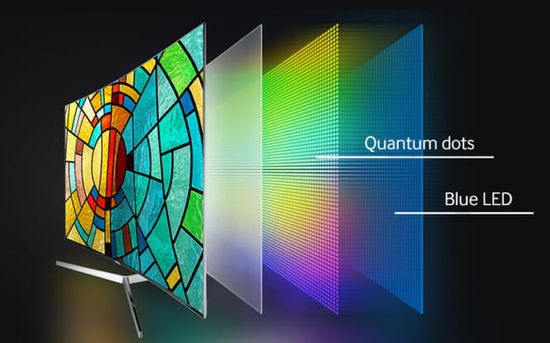
Replacing traditional LEDs with miniature is another breakthrough in LCD technology. The miniature size allowed for a radical increase in the number of LEDs from several hundred to tens of thousands and grouped them into individual Local Dimming zones with individual control. As a result, mini LED backlight further increases the contrast for individual zones of frame, reducing the difference between LED LCD vs OLED TVs.
Epson EpiqVision series
Of course, projector designers also waste no time actively improving their products. The new Epson EpiqVision series perfectly illustrates their progress. Company is positioning the EpiqVision series as an alternative to TVs. It’s conditionally subdivided into EF-100, Mini EF11, Mini EF12 streaming laser projectors, and very bright premium UST Ultra LS300 & LS500.
At CES 2020, the company unveiled the compact Epson EF-100, which became the first model of the new series. It’s available in white and silver (EF-100W) or black and copper (EF-100B).
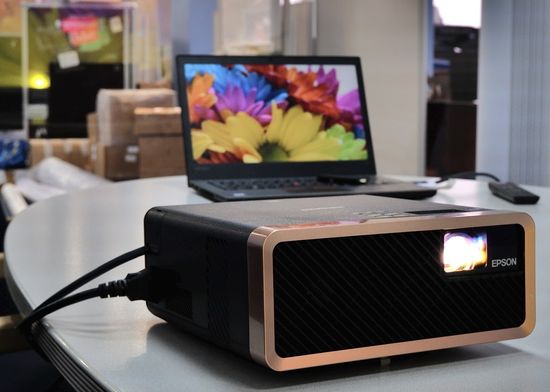
WiFi wireless streaming is supported with a supplied Android TV dongle, which plugs into the projector’s HDMI port. Key features include Epson MicroLaser Array technology, proprietary 9-element lens with seven glass elements, Integrated Audio System, 2,500,000: 1 dynamic contrast ratio, TV tuner, Android OS, Streaming Apps and Google Assistant.
The model costs $ 1,000 and based on 1cm 3-chip 3LCD design (without rainbow). It provides 2,000 ANSI Lm (CLO) brightness, has 1280 x 800 native resolution (accepts signals up to 1080p), uses 8-bit color processing and laser light source with 20,000 hours life time. Its optics with a Throw Ratio of 1.06: 1 provide Image Size up to 150″ (381 cm) with a Throw Distance of 0.7 m to 3.4 m (100″ ~ 2.3 m). The model weighs less than 6 lb (2.7 kg), measures 3,5 x 8,2 x 9 inches (9 x 21 x 23 cm), has a 5.0W mono internal speaker, supports Digital Zoom, horizontal & vertical Digital Keystone. Its audible noise is 29 dB / 26 dB (Eco). In addition, the projector has Mini Jack, HDMI 1.4, USB x 2 and Wireless Networking.
Mini EF11 & EF12
In November 2020, the company unveiled the EF12 for $ 1000 and Mini EF11 at just $ 800.
The EF11 weighs 2,6 lb (1.2 kg) and measures 2,7 x 7 x 7 inches vs 5,1 x 7 x 7 inches of EF12.
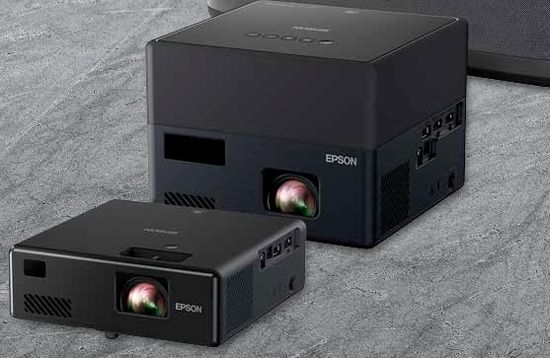
Both models use Epson MicroLaser Array technology, provide Light Output of 1,000 ANSI lm (CLO), dynamic contrast ratio of 200,000: 1, and 1920 x 1080 native resolution (content up to 4K), and have a horizontal & vertical digital keystone. Their audible noise does not exceed 27 dB / 22 dB (Eco).
Unlike the EF100 based on 1cm 3-chip 3LCD, they are designed based on 2cm 3-chip 3LCD and use 10-bit color processing.
All projectors use the same optics, providing Image Size up to 150″ with a Throw Distance of 0.7 m to 3.4 m (100″ screen size ~ 2.2 m).
The differences:
– EF12 uses a Yamaha-designed 2.1 speaker system.
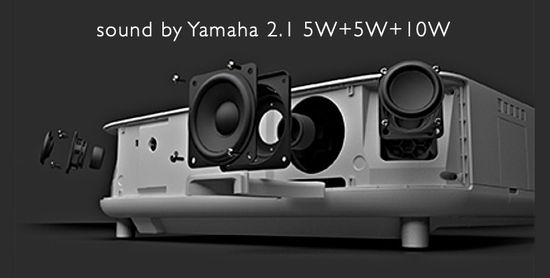
This system includes premium Yamaha drivers and / or a dedicated woofer, which is tuned using Yamaha’s latest AudioEngine DSP and Dolby Digital technologies. It provides a wide sound stage, the quality of which corresponds to soundbar. This system has Theater, TV, Studio, Stadium, Concert, and Karaoke modes. What’s more, the Bluetooth connection allows you to use the projector as a standalone speaker;
– EF12 uses the integrated Android TV platform to stream directly from apps and Chromecast built-in, which is compatible with Google Home and supports Google Assistant. The budget Mini EF11 does not have an Yamaha speaker system, does not support HDR and streaming. It uses an HDMI 1.4 port to connect a streaming device and a USB port for Roku or other streaming stick.
Epson EpiqVision Ultra LS500
This 3LCD model was first announced at CEDIA in Fall 2019 and presented in September 2020 at MSRP $ 4,000 for LS500W / B (white / black, no screen), MSRP $ 5,000 for LS500W / B-100 (100″ UST ALR screen), and MSRP $ 6,000 for LS500W / B -120 (120″ screen). LS500 has unusual design with a large, periscope-style lens and weighs 20,5 lb (9.3 kg) with dimensions (21 x 46 x 38) cm.
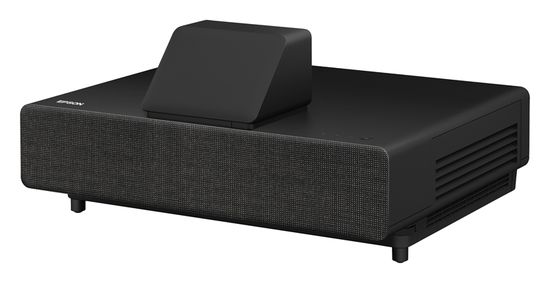
It provides 4,000 ANSI Lm brightness (CLO), 4K resolution with pixel shifting, 2,500,000: 1 dynamic contrast ratio, uses 10-bit color processing, supports Full HD 3D, Digital Zoom, Horizontal & Vertical Digital Keystone, and has 2 x 10.0W internal speakers.
Its optics with a Throw Ratio of 0.29: 1 provide an Image Size up to 130″ at a Throw Distance of 0.2 m to 0.6 m (100” screen ~ 0.4 m).
Min Input Lag 21ms is ideal for gaming.

Except for the blanking option, the keystone, four-corner correction, and digital zoom functions slightly reduce image quality that is a traditional problem.
Like other Epson 4K models, the projector uses a trio of 1080p LCD imagers with Epson’s 4K PRO-UHD pixel-shifting and image processing. This technology actually doubles the number of on-screen pixels per frame. But when viewing 4K content, this effect is visible only at a small viewing distance.
The LS500 supports HDR10 and HLG, has accurate 16-step HDR setting brightness and comes with excellent pre-settings of tone-mapping. The company first used them in premium Home Cinema 5050UB and HC3800.
Full 10-bit HDR processing effectively minimizes bands. Model has a manual Light Output control but mechanical iris is missing.
Epson EpiqVision Ultra LS300
In fact, the LS 300 is the budget version of the LS 500. But it’s lighter (15.9 lbs vs 20.5 lbs), smaller (5.9″ x 18.4″ x 15.7″ vs 8.26″ x 18.1″ x 14, 9″), and her lens is traditionally located in the front recess of its body.
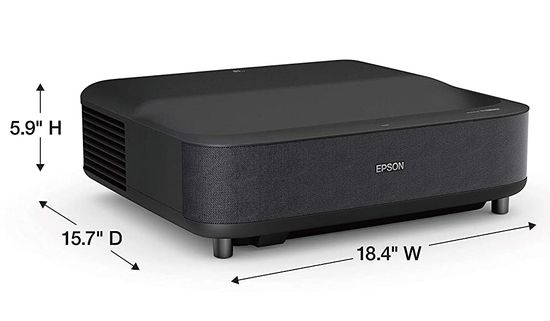
Max Image Size of model reaches 120″ at Throw Distance ~ 15.2″.
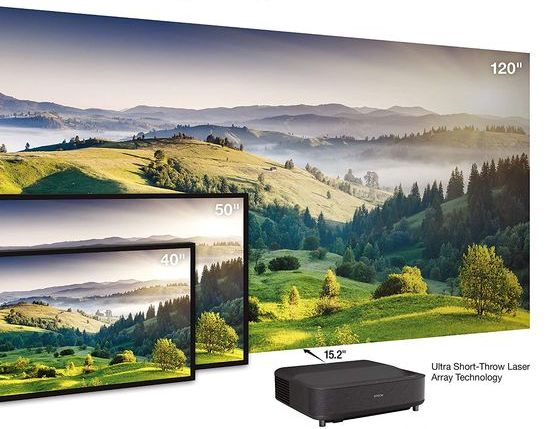
LS 300 is inferior in brightness (3,600 ANSI lm vs 4,000 ANSI lm), dynamic contrast ratio (1,500,000: 1 vs 2,500,000: 1), resolution (1920 x 1080 vs 4K with 4K PRO-UHD pixel-shifting projection technology), and does not support 3D mode.
But it’s much cheaper, ($ 2,000 vs $ 4,000), has a proximity safety detector to automatically turn off the laser, and uses an audiophile 2.1 speaker system by Yamaha.
Like many other modern Epson projectors, model uses Advanced Scene Adaptive Color Correction.
The built-in Chromecast provides wirelessly cast from a smartphone, tablet, or PC. In addition, built-in Android TV provides access to many popular streaming services including YouTube, etc right out of the box.
Like the EH LS500, the projector is offered without screen ($ 2,000), with 100″ UST ALR screen ($ 3,000) and 120″ UST ALR screen ($ 4,000).
The high cost of the screen is due to several factors. First, the effective reflection of the UST projector’s luminous flux requires a special screen coating due to the small angle between the luminous flux and the plane of the screen.
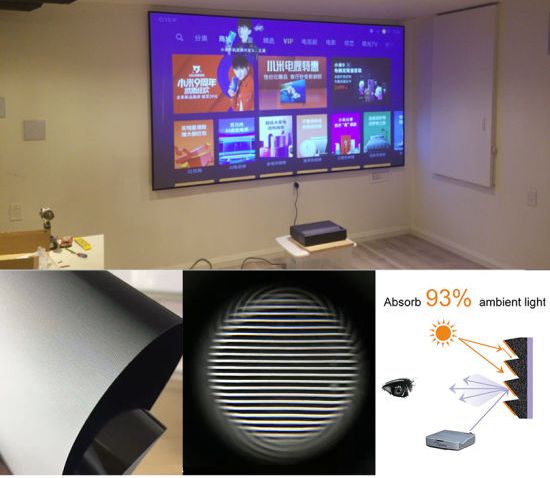
Secondly, any living room projector must operate in a fairly bright ambient lighting. Of course, the high brightness of 3LCD projectors will provide acceptable quality even on a conventional ALR screen, but the image will be paler.
Conclusion
Today the EpiqVision series contains:
– Epson EF 100 – $ 1,000, 2,000 ANSI Lm (CLO) brightness, 1280 x 800 native resolution;
– Mini EF12 – $ 1,000, 1,000 ANSI Lm ( CLO) brightness, 1920 x 1080 native resolution, innovative 2.1 speaker system by Yamaha;
– its budget Mini EF11 version – $ 800, 1,000 ANSI Lm ( CLO) brightness, 1920 x 1080 native resolution, without Yamaha’s speaker system, HDR and streaming;
– the brightest EH LS500 4K UST – $ 4,000 / $ 5,000 / $ 6,000 (depending on the UST ALT screen,) 4,000 ANSI Lm (CLO) brightness, 4K resolution with PRO-UHD pixel-shifting projection technology, but without Yamaha’s 2.1 speaker system;
– EH LS300 UST – $ 2,000 / $ 3,000 / $ 4,000 (depending on the UST ALT screen), 3,600 ANSI Lm (CLO) brightness, 2.1 speaker system by Yamaha, but 1920 x 1080 resolution without pixel-shifting.
In fact, the series covers the entire price segment of streaming smart projectors ranging from $ 800 (Mini EF11) to $ 6,000 (EH LS500 4K UST with 120-inch UST ALR screen). According to many experts, the EH LS300 has the best value for money.
Of course, the screen price significantly influences the choice. In turn, it depends on the viewing conditions. Even with a conventional ALR screen, their very high brightness will provide high quality in a room without direct sunlight or with blinds on the windows. But it will be desirable when viewed on the veranda.
By comparison, the most affordable 85-inch Samsung 4K LCD TV without 3D costs $ 2,000 today.
This video demonstrates the Epson EpiqVision Ultra LS500 Laser Projection TV.
P.S.
This fall, Hisense has formally announced availability of the newest L9G Laser TV with innovative TriChroma Laser technology that delivers an unprecedented 107% coverage of the BT.2020 color space.
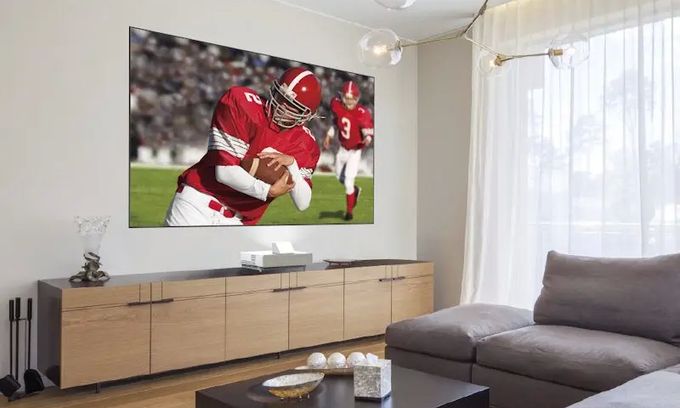
Pingback: Optoma CinemaX 4K living room laser DLP projectors Review - The Appliances Reviews
Pingback: Epson EpiqVision LS300 UST projector Review - The Appliances Reviews
Pingback: Epson EpiqVision LS500 UST laser projector instead of a TV? - The Appliances Reviews
Pingback: Living room projector vs TV Review - The Appliances Reviews